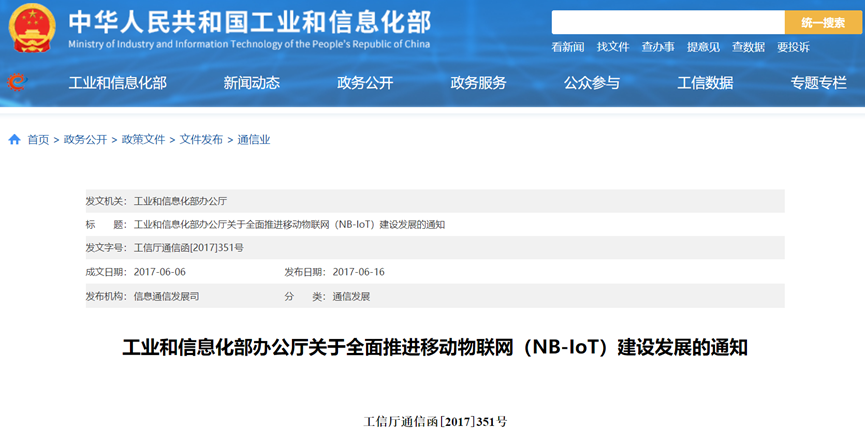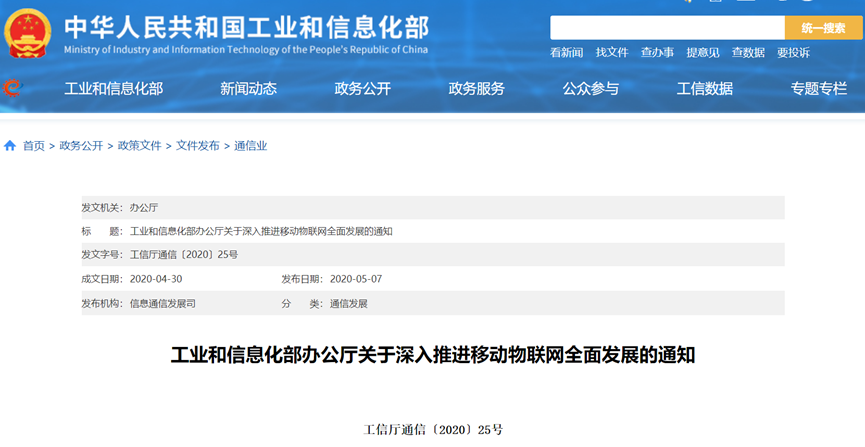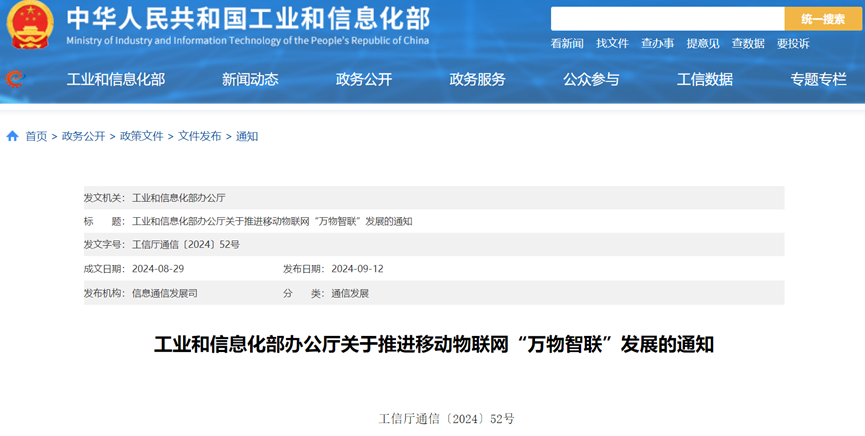Source: IoT Think Tank
Recently, the Ministry of Industry and Information Technology (MIIT) released the “Notice on Promoting the Development of Mobile IoT ‘Everything Connected'”, setting goals for the development of mobile IoT by 2027. This is the third document released by MIIT regarding the overall development of mobile IoT, following the “Notice on Fully Promoting the Construction and Development of Mobile IoT (NB-IoT)” released in 2017 and the “Notice on Deepening the Comprehensive Development of Mobile IoT” released in 2020. From the development history of the IoT industry in recent years, it can be seen that each document release has had a significant impact on the industry, shaping the key paths and measures for advancing mobile IoT in the coming years. In this article, I will analyze the impact of this document in conjunction with the content of these important documents.
Three Milestones Formed by Three Important Mobile IoT Documents
Comparing the three documents issued by MIIT regarding the overall development of mobile IoT, it is evident that each document was released at important junctures in the industry’s development. The highlights presented in these documents can be said to have milestone significance, profoundly impacting the subsequent development of mobile IoT and contributing to the current industrial landscape. In my view, these three comprehensive development documents for mobile IoT have formed the following three milestones:
1. 2017 Document: Support Policies for the First Independent Industrial System of Mobile IoT

In June 2017, the General Office of MIIT issued the “Notice on Fully Promoting the Construction and Development of Mobile IoT (NB-IoT)”, marking the first time that the concept of “mobile IoT” was officially introduced in a document by the industry authority. This indicates that the independent system of mobile IoT had begun to take shape, and the issuance of policy documents for this independent system reflects the high importance attached by the authority and its desire for rapid development.
As early as February 2013, the State Council issued the “Guiding Opinions on Promoting the Orderly and Healthy Development of the Internet of Things”, which garnered widespread attention from society at large. The IoT industry began to experience rapid development. However, at this time, an independent industrial system for mobile IoT had not yet formed. The industry was more focused on short-range communication technologies such as WiFi, Zigbee, and Bluetooth, with consumer IoT products like smart home devices and wearables becoming hot topics.
In this context, although there were many IoT applications based on long-range communication technologies on the market, most still relied on traditional 2G/3G/4G cellular network technologies, which were primarily designed for mobile phones, focusing on voice call quality and high-frequency data traffic growth. They did not consider the characteristics of IoT terminals, such as low frequency, small packets, and low power consumption. It was only because traditional cellular networks had surplus capacity that they could open some resources for IoT use. In this situation, these applications based on long-range communication technologies could not be considered true “mobile IoT” nor could they form an independent industrial system.
A turning point occurred in June 2016 when the international standards organization 3GPP froze the first version of the NB-IoT standard. This standard was specifically designed for the characteristics of IoT terminals, representing a complete mobile cellular network standard that is independent and tailored for IoT. With the impetus from the NB-IoT standard, the end-to-end industrial chain for NB-IoT, including chips, modules, terminals, networks, platforms, and applications, rapidly developed, leading to the accelerated formation of the first independent mobile IoT industrial system. By 2017, pilot projects for NB-IoT applications increased, and the independent industrial system had begun to take shape.
Against this backdrop, MIIT released the first policy document specifically for mobile IoT, which focused more on the development of the NB-IoT industrial ecosystem. During this period, NB-IoT almost represented the true meaning of mobile IoT. Following the release of the document, NB-IoT experienced rapid growth, reaching 100 million connections by 2020.
2. 2020 Document: Sounding the Horn for 2G/3G Network Shutdown and Building a Large Connection System for Mobile IoT

In May 2020, the General Office of MIIT released the “Notice on Deepening the Comprehensive Development of Mobile IoT”. I believe the biggest highlight of this document is its first formal public declaration to promote the shutdown of 2G/3G networks. The document states, “Accurately grasp the evolution trend of global mobile IoT technology standards and industrial patterns, and promote the migration of 2G/3G IoT services to new networks.” The introduction of this policy provided reassurance to the industry, and in the following years, the number of IoT connections based on 2G/3G networks rapidly declined, with cellular networks designed specifically for IoT becoming the mainstay of mobile IoT.
At this point, mobile IoT was no longer limited to NB-IoT; it also included LTE Cat.1 and 5G, forming a relatively rich and comprehensive system. This has initially established an ecosystem for the collaborative development of low, medium, and high-speed rates, laying the foundation for the construction of a large connection system for mobile IoT.
While Cat.1 is based on 4G LTE, it has been optimized for the characteristics of IoT and is truly a standard specifically for mobile IoT. The first standard for Cat.1 was frozen in 2009, well before the first standard for NB-IoT. However, due to the limitations of the 4G framework, the costs of Cat.1 terminals remained high for a long time, resulting in very few connections. By around 2020, 4G networks achieved nearly ubiquitous coverage across the country, and the costs of chip modules significantly decreased. Coupled with the demand for Cat.1 created by the many scenarios developed for NB-IoT, and importantly, the clarity of the 2G/3G network shutdown policy, the industry began to see a clear expectation for Cat.1 to replace 2G/3G.
Additionally, when the document was released, 5G had been commercially available for nearly a year. Since 5G’s initial standard design considered support for IoT, especially with 5G URLLC and mMTC being born specifically for IoT, 5G has also become a core component of the entire mobile IoT system. However, in recent years, the number of IoT connections based on 5G has not yet formed a large-scale trend.
It can be said that the 2020 document released by MIIT marked a significant moment by clarifying the 2G/3G network shutdown policy, leading to a substantial development of mobile IoT. The situation of “more connections than ever” has formed, with Cat.1 being the primary beneficiary, driving its current dominance in mobile IoT connections.
3. 2024 Document: Accelerating the Transition of Mobile IoT from ‘Everything Connected’ to ‘Everything Intelligent’

This time, MIIT released the “Notice on Promoting the Development of Mobile IoT ‘Everything Intelligent'”, which proposed accelerating the transition of mobile IoT from “everything connected” to “everything intelligent”. I believe this is the biggest highlight of this policy document and an important direction for the future development of mobile IoT.
As of the end of July 2024, the number of mobile IoT connections reached 2.547 billion, accounting for 59% of the total connections in mobile networks. The number of mobile IoT connections continues to accelerate. In this context, mobile IoT connections have become deeply ingrained in society, breaking down barriers, and the billions of connections bring vast scenarios and massive data. How to realize the intelligent extraction of data value from these scenarios is a pressing issue for the development of mobile IoT. Therefore, the authorities have elevated “everything intelligent” to a more important position, which is also a key point of this policy document.
Although the “Notice on Promoting the Development of Mobile IoT ‘Everything Intelligent'” does not specify concrete goals for “everything intelligent”, it repeatedly emphasizes the integration of mobile IoT with technologies such as artificial intelligence and big data. Especially in the chapter on “Deepening Intelligent Integration Applications”, it includes requirements for industrial digital transformation, intelligent social governance, and intelligent public life, focusing on enhancing the intelligent application levels of various applications to achieve ultimate value realization.
In my view, just as with the previous two documents, the new direction reflected in this policy document will be fully manifested in the industry’s development, market focus, and corporate strategies in the coming years, promoting a new pattern in the mobile IoT industry that fully embodies the trend of “everything intelligent”.
Analyzing the Development Pattern of Mobile IoT from This Document Release
Based on the requirements outlined in this document and the development history of mobile IoT, several new trends for future mobile IoT development have begun to take shape. I will analyze them from the following aspects:
1. Deeper Integration of IoT and Artificial Intelligence, Entering a New Stage of Applications
Accelerating the transition of mobile IoT from “everything connected” to “everything intelligent” results in the further evolution of the AIoT industrial ecosystem, fully utilizing the latest achievements of cutting-edge technologies to achieve innovation in AIoT applications. AIoT is not a new concept; the industry has proposed it years ago, and many existing scenarios are also the results of AI+IoT integration. However, previously, AIoT was more about mutual assistance and support, where IoT focused more on connectivity services, and AI vendors merely used IoT data for scenario design and model training. The future direction is for these two to become an integrated entity, especially as IoT vendors increasingly incorporate AI as a native capability into their end-to-end business and product systems, providing comprehensive services that combine AI and IoT.
Currently, generative artificial intelligence (GenAI), represented by large models, has become a hot topic in the economy and society. IoT vendors, especially some mobile IoT companies, are actively embracing GenAI. For example, Japan’s IoT virtual operator Soracom has deeply embedded GenAI functionality into its mobile IoT connection platform, simplifying the management of large IoT deployments through natural language data analysis. The passive IoT startup Wiliot has launched the first GenAI chatbot, WiliBot, to enhance the user experience in its supply chain management application scenarios. I believe more IoT vendors will promote the deep integration of GenAI and IoT, creating broader application scenarios and driving AIoT towards GenAIoT.
2. Diversification of Mobile IoT Technology Systems to Support Various Connection Needs
In contrast to the 2020 policy document, which proposed “establishing a comprehensive ecosystem for mobile IoT with collaborative development of NB-IoT, 4G (including LTE Cat.1), and 5G”, this policy document proposes a “comprehensive ecosystem for mobile IoT based on 4G (including LTE Cat.1) and 5G (including NB-IoT and RedCap) with high-low pairing, ubiquitous intelligence, and safety and reliability”. This indicates the evolution of the mobile IoT technology system.
Among them, NB-IoT has been integrated into the 5G system, as the International Telecommunication Union approved the inclusion of NB-IoT in the 5G standard family in July 2020. With the evolution of the 5G standard system, NB-IoT continues to be optimized as part of the 5G standard system. RedCap is a native technology of 5G and is expected to become a key player in 5G IoT connections in the future. Previously, MIIT released the “Notice on Promoting the Evolution and Application Innovation of 5G Lightweight (RedCap) Technology” in October 2023 and the “Notice on Launching the 2024 5G Lightweight (RedCap) Connectivity Action” in April 2024, outlining the development goals for RedCap.
Currently, NB-IoT and Cat.1 have become the main forces in mobile IoT connections. The policy document states that by 2027, the number of mobile IoT terminal connections is expected to exceed 3.6 billion, with 4G/5G IoT terminal connections accounting for 95%. Achieving this goal hinges on breakthroughs in RedCap.
Of course, in addition to NB-IoT, Cat.1, and RedCap, the document also mentions passive IoT, satellite IoT, and other technologies. The promotion of these connection technologies will form a more diversified mobile IoT technology system in the future, covering almost all scenarios that require various power consumption and distance needs.
3. Broadening and Deepening Application Scenarios to Enhance Mobile IoT Penetration
This policy document addresses application scenarios focused on industrial digitization, intelligent social governance, and intelligent living, but with further breadth and depth. It especially proposes clear application scenarios and goals for some key areas, ensuring that mobile IoT services move beyond mere connectivity to achieve practical application functionalities. This also emphasizes the direction of “everything intelligent”, laying the groundwork for the deep integration of AIoT.
Some new application scenarios explicitly stated in the document deserve the industry’s attention and layout. For instance, low-altitude intelligence is a proposed application direction, with the low-altitude economy being a new field with vast market potential. The capability of low-altitude networks is one of the significant challenges, and the trend of integrated development of mobile IoT can provide strong support for the low-altitude economy. Additionally, the document encourages innovation in 5G RedCap vehicle applications. Currently, a considerable portion of connected vehicles is standard, but they predominantly use 4G networks. Considering the vehicle lifecycle and connected driving experience, as well as the focus on promoting 5G IoT, RedCap integration into vehicles is expected to become a key area in the coming years.
4. Further Visibility of Mobile IoT Value to Enhance Practitioner Confidence
MIIT has stated in its interpretation of this policy document that to scientifically and reasonably reflect the value of the mobile IoT industry and create a favorable environment for the healthy development of the industry chain, the “Notice” clearly proposes to optimize the value assessment methods of mobile IoT. It encourages basic telecommunications enterprises to comprehensively assess the overall value of mobile IoT, reflecting the connection value of mobile IoT cards, hardware terminals, software platforms, and the driving value for growth in computing and storage businesses. It also optimizes revenue statistics to include IoT terminal hardware, platform services, and other aspects into communication service revenue, incorporating driving business revenue into mobile IoT business statistics.
Previously, the industry’s perception of the value of IoT was largely limited to connectivity. The low cost of IoT connections has led to low satisfaction among IoT practitioners and has severely underestimated the value of IoT by industry users. IoT is becoming an essential foundation for digitalization. In many industrial digitalization scenarios, IoT functionality is a necessary feature, but its role may not be directly apparent, leading to a lack of recognition of its value. Additionally, the infrastructure formed by IoT can leverage and multiply other values through innovation in industry applications and data mining, which are not objectively reflected. Some countries and regions have recognized the potential value brought by IoT. For example, the EU’s “Data Act”, which came into effect earlier this year, is the first legislation targeting IoT data by a major global economy, clarifying the rules for the circulation of IoT data and accelerating the transformation of data element value, reflecting the value of IoT beyond mere connectivity.
This policy document proposes optimizing the value assessment methods for mobile IoT. Although it primarily targets basic telecommunications enterprises, the optimized value assessment methods can serve as a reference for other IoT companies, further elucidating the value brought by IoT. Through innovative value assessment methods, society can gain a new understanding of the value of IoT, which will further affirm the achievements of practitioners and boost their confidence.
“Everything Intelligent” has become a definitive trend for the future development of IoT. The release of the “Notice on Promoting the Development of Mobile IoT ‘Everything Intelligent'” has reaffirmed this direction from the perspective of the authorities and once again strengthened the confidence of the industry while providing clear expectations for the future. It will require the collective efforts of all parties to advance the development of mobile IoT and accelerate the integration of the digital economy with the real economy.